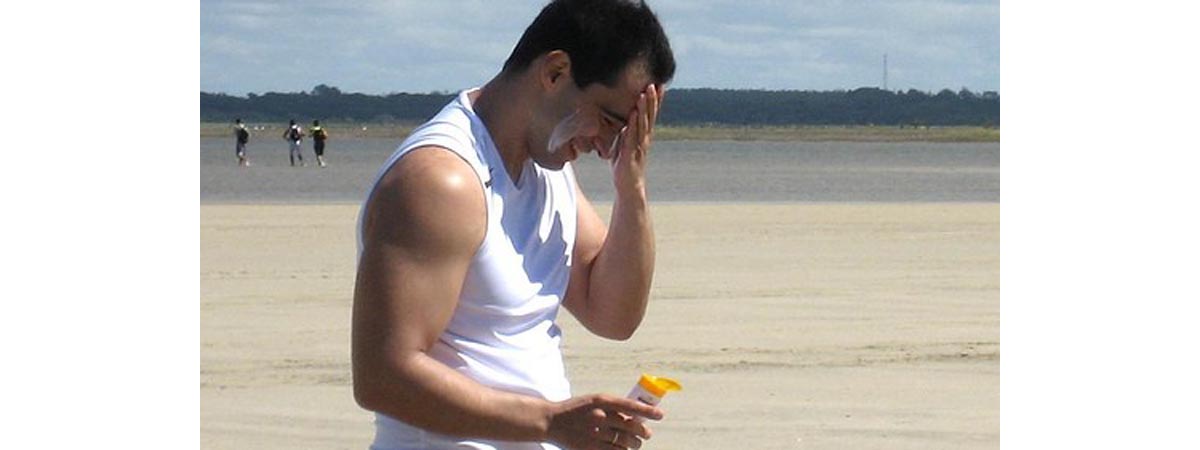Table of Contents
Unless you live at the ground level of a dense tropical rainforest or in a cold, cloudy climate like the Aleutian Islands, you need to use sunscreen during the summer. But how you use sunscreen also makes a difference. Here are seven more common sunscreen mistakes.

4. It's OK, many people believe, to put on sunscreen first thing in the morning and forget about it the rest of the day.
Even the best sunscreen products only last about two hours. If you perspire, if you get a spritz from an overhead mister, or if the sunscreen rubs off, you may need to reapply sun protection even sooner than that. Your skin uses some of the chemicals in sunscreen to stop the creation of free radicals of oxygen that trigger inflammation and cell damage. The more you are in the sun, the faster these chemicals are used up.
5. It's OK to rely on water-proof sunscreen.
"I don't need to put on more sunscreen when I get out of the water," you might say, "because I use a water-proof skin care product." Sorry, "water-proof" sun protection products usually don't live up to their name. In fact, the Food and Drug Administration doesn't even allow the manufacturers of sunscreen to use the term "water-resistant" any more. The best products seem to stand up to splashing water or perspiration for 40 to 80 minutes. But after 80 minutes of exposure to moisture, there isn't any product that continues to work.
6. I'm wearing clothes. I can't get sunburn.
According to measurements made on volunteers at Australia's University of Southern Queensland at Toowoomba, actually wearing clothes isn't enough to offer complete protection against the sun, at least in the bright, sunny regions of the world like Australia, Africa, and the southwestern United States. However, wearing a broad-rimmed hat, long sleeves, pants that reach to the ankles, and gloves is more protective than not. Garments are more protective against UV radiation, especially cotton garments, after the first time they have been washed. The more often you wash your clothes, the more sun-protective they become as holes between threads shrink.
7. You only need to put on sunscreen when it's hot.
In Texas, where I live, the most severe sunburns usually occur on the first really nice day in March, when the temperature might reach 72 degrees F (22 degrees C). Sunburn is caused by sunlight, not heat. It's possible even to get sunburn when snow skiing, if you don't use appropriate protection.
8. You always need to shell out the big bucks to get the highest SPF protection possible.
SPF 30 sunscreens block out about 96% of the sun's harmful UV rays. SPF 70 sunscreens block out about 99% of the sun's harmful UV rays. It's not possible to block 100% of the sun's rays (although titanium dioxide, the sunscreen associated with white noses on lifeguards, comes closest). You are likely not to need higher-SPF sunscreen, just to use lower-SPF sunscreen more often.
9. I don't need sunscreen. I just need aloe vera (or shaving cream, vitamin C, vitamin E, vinegar, ice, cold showers, baking soda, green tea, honey, or oatmeal) to treat sunburn when it happens.
All of these natural remedies help you get over sunburn--but once the skin is burned, DNA damage is done. Prevention is better than treatment for sunburn, and preventing burned skin also prevents skin cancer.
10. What's going on inside my body doesn't have anything to do with how I react to the sun.
There are a variety of foods and medications that can make your skin a lot more sensitive to the sun. The common blood pressure medication lisinopril (and just about any antihypertensive medication in the ACE-inhibitor class, their generic names ending in -il) can make you more sensitive to the sun. Eating too much celeriac or parsley or taking St. John's wort can increase your risk of sunburn.
On the other hand, eating carrots on a regular basis can help prevent sunburn and solar skin damage. One or two carrots a day, however, is enough. Eating more than a kilo of carrots per week prevents sunburn, but can turn your skin orange.
- Diaz JH, Nesbitt LT Jr. Sun exposure behavior and protection: recommendations for travelers. J Travel Med. 2013 Mar-Apr. 20(2):108-18. doi: 10.1111/j.1708-8305.2012.00667.x. Epub 2012 Dec 4. PMID: 23464719.
- Parisi AV, Kimlin MG, Mulheran L, Meldrum LR, Randall C. Field-based measurements of personal erythemal ultraviolet exposure through a common summer garment. Photodermatol Photoimmunol Photomed. 2000 Jun.16(3):134-8.
- Photo courtesy of Peter Dutton by Flickr : www.flickr.com/photos/joeshlabotnik/782119885/
- Photo courtesy of Rafael by Flickr : www.flickr.com/photos/perjano/398804048/


Your thoughts on this